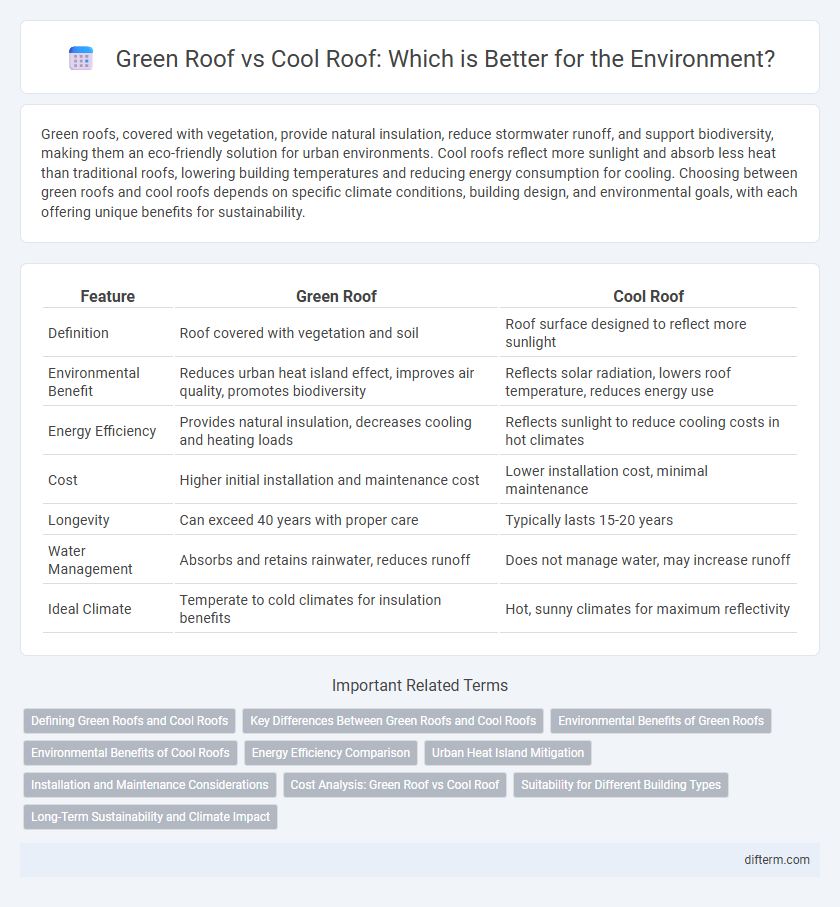Green roofs, covered with vegetation, provide natural insulation, reduce stormwater runoff, and support biodiversity, making them an eco-friendly solution for urban environments. Cool roofs reflect more sunlight and absorb less heat than traditional roofs, lowering building temperatures and reducing energy consumption for cooling. Choosing between green roofs and cool roofs depends on specific climate conditions, building design, and environmental goals, with each offering unique benefits for sustainability.
Table of Comparison
| Feature | Green Roof | Cool Roof |
|---|---|---|
| Definition | Roof covered with vegetation and soil | Roof surface designed to reflect more sunlight |
| Environmental Benefit | Reduces urban heat island effect, improves air quality, promotes biodiversity | Reflects solar radiation, lowers roof temperature, reduces energy use |
| Energy Efficiency | Provides natural insulation, decreases cooling and heating loads | Reflects sunlight to reduce cooling costs in hot climates |
| Cost | Higher initial installation and maintenance cost | Lower installation cost, minimal maintenance |
| Longevity | Can exceed 40 years with proper care | Typically lasts 15-20 years |
| Water Management | Absorbs and retains rainwater, reduces runoff | Does not manage water, may increase runoff |
| Ideal Climate | Temperate to cold climates for insulation benefits | Hot, sunny climates for maximum reflectivity |
Defining Green Roofs and Cool Roofs
Green roofs consist of vegetation layers installed on building rooftops to enhance insulation, manage stormwater, and improve urban biodiversity. Cool roofs use reflective materials designed to reflect more sunlight and absorb less heat, thereby reducing rooftop temperatures and lowering cooling energy demand. Both roofing systems contribute to mitigating urban heat islands but differ in structure and environmental benefits.
Key Differences Between Green Roofs and Cool Roofs
Green roofs consist of living vegetation layers that provide natural insulation, reduce stormwater runoff, and enhance biodiversity, while cool roofs utilize reflective materials designed to minimize heat absorption and lower surface temperatures. Green roofs contribute to urban cooling by evapotranspiration and improve air quality, whereas cool roofs primarily reduce building energy use by reflecting solar radiation. Maintenance requirements differ significantly, with green roofs needing ongoing plant care and irrigation, in contrast to the relatively low maintenance of cool roofs.
Environmental Benefits of Green Roofs
Green roofs enhance urban biodiversity by providing habitats for various plant and animal species, while also improving air quality through natural filtration of pollutants. They reduce the urban heat island effect by absorbing sunlight and promoting evapotranspiration, leading to lower ambient temperatures. Furthermore, green roofs mitigate stormwater runoff by retaining rainwater, decreasing the burden on drainage systems and reducing the risk of flooding.
Environmental Benefits of Cool Roofs
Cool roofs significantly reduce urban heat island effects by reflecting more sunlight and absorbing less heat compared to traditional roofing materials, lowering rooftop temperatures by up to 30%. This temperature reduction decreases energy consumption for air conditioning, cutting greenhouse gas emissions and promoting sustainability in urban environments. Cool roofs also enhance roof longevity and improve indoor comfort, contributing to overall environmental resilience.
Energy Efficiency Comparison
Green roofs improve energy efficiency by providing natural insulation with vegetation layers that reduce heat absorption, leading to lower cooling and heating costs. Cool roofs reflect more sunlight using reflective materials, significantly decreasing roof surface temperatures and reducing cooling energy demands. Studies show green roofs offer better thermal regulation over multiple seasons, while cool roofs excel in hot climates by minimizing daytime heat gain.
Urban Heat Island Mitigation
Green roofs reduce urban heat island effects by providing vegetation that cools the air through evapotranspiration and increases shading, lowering surface temperatures significantly. Cool roofs use reflective materials to bounce sunlight and absorb less heat, effectively reducing rooftop temperatures and decreasing heat transfer to buildings. Combining green roofs with cool roofing strategies enhances urban heat island mitigation by maximizing cooling benefits and energy savings in densely populated areas.
Installation and Maintenance Considerations
Green roofs require structural support to bear the weight of soil and vegetation, with installation involving waterproof membranes, root barriers, and proper drainage systems to prevent water damage. Maintenance demands regular irrigation, weeding, and inspection for plant health and system integrity, which can increase long-term costs and labor. Cool roofs generally have simpler installation processes using reflective coatings or materials and require less maintenance, primarily periodic cleaning to sustain solar reflectance and prevent debris accumulation.
Cost Analysis: Green Roof vs Cool Roof
Green roofs typically involve higher installation costs, averaging $10 to $25 per square foot, compared to cool roofs which range from $5 to $12 per square foot. However, green roofs offer long-term savings through enhanced insulation, reducing energy costs by up to 25%, while cool roofs primarily lower cooling expenses by reflecting sunlight. Maintenance costs for green roofs are generally higher, but they provide added benefits like stormwater management and extended roof lifespan that can offset initial investments over time.
Suitability for Different Building Types
Green roofs provide excellent insulation and stormwater management, making them highly suitable for commercial buildings, schools, and urban residential complexes with flat or low-slope roofs. Cool roofs reflect more sunlight and absorb less heat, making them ideal for large warehouses, industrial buildings, and homes where roof structure or weight limitations prevent green roof installation. Suitability depends on factors like roof load capacity, climate, and building function, influencing the choice between the vegetative benefits of green roofs and the energy efficiency of cool roofs.
Long-Term Sustainability and Climate Impact
Green roofs enhance long-term sustainability by improving urban biodiversity, reducing stormwater runoff, and providing natural insulation that lowers energy consumption over time. Cool roofs primarily reduce heat absorption, decreasing urban heat island effects and energy use for cooling, but lack the ecological benefits of vegetation. The combined implementation of green and cool roofs offers a comprehensive climate impact strategy by mitigating temperature extremes and promoting carbon sequestration in urban environments.
green roof vs cool roof Infographic

 difterm.com
difterm.com